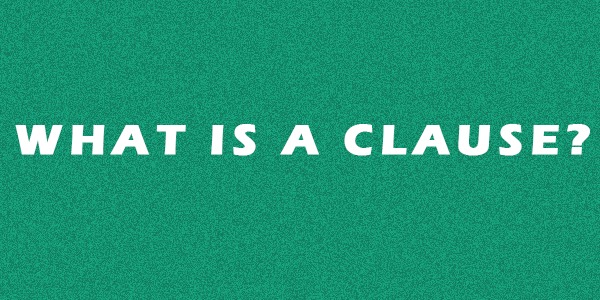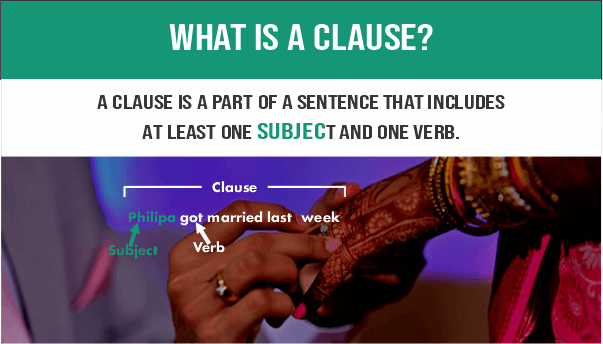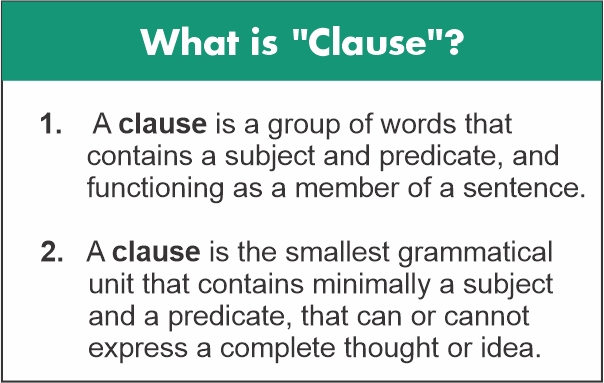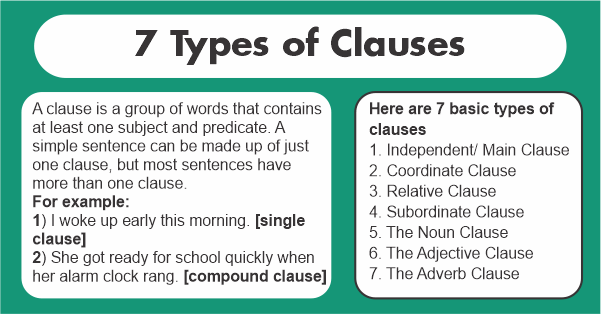What is a Clause?Clauses can be defined as the collection of words that comprise of the subject and the verb that relate to one another. This connection is essential because a clause, as opposed to being just a collection of words, transmits information about what the subject is or is doing. A clause can frequently-but not always-serve as an independent statement since it communicates action or a state of existing. 
One clause or several clauses can be present in a sentence. A clause can only be defined by the requirement that it have a linked subject and verb. Because English uses clauses for a variety of purposes, there are many different methods to organize and combine them. What Is a Clause in a Sentence?A combo of words is usually known as a clause. As stated earlier, it consists of a subject and a verb. Simply read this guide to learn more about clauses, including examples of various clause kinds and much more. How Do Clauses Work?A clause is a component of written English. To put it simply, a clause is a string of words that essentially comprise of the subject and the verb. Note: A sentence is made up of clauses. The sentence may include a main clause, a coordinate clause, or a subordinate clause. Individuals must be taught what a clause is since it is one of the fundamental components of written English. A clause might look like this : The swift red squirrel scurried up a tree. The swift red squirrel is the subject of this sentence, and the verb used is "scurried." Another name for this is a simple sentence. A main/independent clause, a subordinate clause, an adjective clause, and a noun clause are the three primary types of clauses that can be employed in a sentence. Read on to get more clarity on the concept of clauses. 
Classifying English clausesA clause is something that comes in between a phrase and a sentence when it comes to conveying the complete notion. It often as the potential to exist independently as a sentence, whereas in comparison, a phrase cannot. Read on for a quick explanation of the difference between a phrase and a clause: Purrs so loudly is a phrase. That cat purrs so loudly, is a clause. In this case, the clause might stand alone as a sentence or it can also be a part of a long sentence. For instance : That cat purrs so loudly when she is hungry. How Do Clauses Function in English?Clauses can have three different purposes: They can be used as a noun, adjective, or an adverb. This is an illustration of a noun clause : Eliza perfectly understood what he said. Everything she said in this instance functions as a noun since it communicates the particular "thing" that Eliza, the sentence's subject, understands. His justification/response can be used in place of what he said, and the statement still makes sense: Eliza perfectly understood his justification. Try substituting a noun for a clause to see whether it passes the test of being a noun clause. Your sentence has a noun clause if it still makes sense. Here are two more instances of noun clauses with swapped-in nouns to illustrate them: They recalled what the main speaker addressed. They recalled the main speaker's lecture. I do not know how the organization operates training. I do not know their training program. Similar to how a noun clause fills the role of a noun, an adverbial clause fills the role of an adverb. For instance :
We bet you can figure out how an adjective clause functions based on the other two types. If you can't, then here it is: In its own sentence, an adjective clause functions as an adjective. To demonstrate them, below are a few examples with adjectives substituted: My roommate, who rides a bike, said it's a nice weekend to pedal. My bike rider friend said it's a nice weekend to pedal. Irrespective of the time of day we go, we always encounter the barking dog. Irrespective of time, we always encounter the loud dog. 
How Can You Spot a Clause in the Sentence?Through a phrase's structure and selection of nouns, adjectives, and connectives, you may recognize various clause types in a sentence in a variety of straightforward ways. Read this straightforward explanation of how to recognize a clause. Noun clause: Look to see if you can substitute the dependent clause with the pronouns (he/she/it/them) or nouns to determine whether it is a noun clause. Adjective clause: A clause that serves as both an adjective and often a relative clause is known as an adjective clause. It specifies a noun or pronoun just the way an adjective does. Adverb clause: It is a dependent clause which lacks coherence on its own. For it to be meaningful, it needs a different independent clause. They are also referred to be dependent adverb clauses for this reason. An adverb phrase is identifiable because it provides an explanation for the how, when, where, and why of an event. It provides additional info and provides justification for the independent clause. What Are Examples of Clauses?During the day, Deany slept in a casket. "Deany" is the clause's subject. The verb is "napped." Since there isn't a verb, "during the night" is used instead. When the Moon glowed, she crept into the darkness. "The Moon" is the object of the first clause. "Shine" is the verb. "she" is the subject of the second clause. And "crept" is the verb. He chased a pretty milkmaid who resided in the nearby village. In this sentence, "he" is the subject of the first clause, 'He chased a pretty milkmaid'. Whereas the term "chased" is the verb, and "who" is the subject of the second clause. Types of Clauses1. Main ClauseThe main clause is a set of words that can stand alone as a full sentence and comprises both a subject and a verb. Sine they don't require any other info to make sense, main clauses are also regularly alluded to as independent clauses. Without the assistance of another clause, they can stand on their own just fine. They convey a comprehensive idea. Two major clauses or a main clause and a different sort of clause can make up a sentence. The second clause relies on the main clause to sound right when there is only one primary clause and another distinct type of clause. Main clause illustrations include: the dog barked his bike broke down on the highway the kid giggled loudly 2. Subordinate ClauseSubordinate clauses, also known as dependent clauses, require a little more support to make sense than main clauses do. A subordinate clause is a clause that cannot function alone as a full sentence despite having a subject and a verb. It lacks a complete notion, just as a primary clause. Subordinating conjunction must be used to connect it to the main sentence. Examples of Subordinate clauses include: sitting calmly, the bitch gave birth. The bitch that was busy giving birth sat calmly. Looking at the sky, she exhaled nostalgically. Because "sitting calmly" is not a complete concept, it is a subordinate clause. It requires the primary clause" the bitch gave birth" in order to sound right to the audience or readers. Hence because of, this subordinate clause is known as the type of dependent clause. 3. Coordinate ClauseWhen you join two independent clauses that are equally important, you create a coordinate clause. So they are the coordinating conjunctions between these sentences. It can be challenging to distinguish between coordinate clauses and subordinate clauses because they both merge two sentences. To begin with, consider the definition of "coordinate" that can help you in understanding the distinctions between the two. To coordinate is to collaborate on an equal basis. A coordinating clause consists of two equally significant sentences. Just keep in mind that two sentences are joining forces to form one coordinate clause in a coordinating clause. Coordinative clause examples encompass:
A coordinating conjunction joins these two clauses together. I like caramel, and I like candies. I like caramel and I like candies are both main clauses that stand on their own. The coordinating conjunction "and" has connected them to form a coordinate clause. 
4. Adjective Clause A relative pronoun (such as who, whose, which, or that) or a relative adverb is used to start an adjective clause (when, where, or why). Along with a subject and/or a verb, this kind of sentence also contains a relative pronoun or an adverb. An adjective clause is a dependent clause, much like a subordinate clause, since it depends on the remaining of the sentence to make perfect sense. A helpful hint for recognizing an adjective clause is to keep an eye out for specific words. Only relative pronouns (who, whose, whose, which, or that) and subordinate conjunctions can be used to initiate an adjective phrase (when and where). Adjective clause examples encompass:
An adjective clause is a dependent clause, much like a subordinate clause, since it depends on the remainder of the sentence to make sense. Whose identities are on the list isn't a full notion. Thus on its own, it would not really make sense. 5. Noun ClauseAny sentence that functions similarly to a noun is referred to as a noun clause. In other terms, a noun could be substituted for the clause, and the sentence would still make sense. Noun clauses function similarly to nouns and pronouns. It can't stand independently as a sentence because it only has a subject and a verb, and not a full thought. Pronouns or subordinating conjunctions are used to begin noun clauses. These are a few illustrations of noun clauses.
6. Adverb ClauseAdverb clauses are dependent clauses that lack coherence on their own. For it to make sense, it needs a different independent clause. For this reason, they are sometimes called dependent adverb clauses. Comparable to how an adverb alters a sentence, an adverb clause provides a description. Even though it has a subject and a verb, it does not fully communicate a thought. Adverb clause examples encompass:
7. Primary ClauseThese are complete sentences that can exist alone or serve as the focal point of any Complex or Compound Sentence since they have a Subject (Noun/Pronoun), Finite Verb, and an Object. Though labeled differently, Independent and Principal Clauses have the same functionality. Examples:
8. Non-finite ClauseA non-finite clause is a subordinate clause which is built on an infinitive verb and a primary clause. The Participial Phrase stands in for the Sentence's Subject or Object in a Participle. Examples:
How To Combine The ClausesOne must connect clauses while writing a sentence that contains more than one independent component. You must employ at least one independent clause in every statement you compose. Also, inclusion of independent clauses with the other clauses the sentences depend on those other clauses. A compound sentence comprises of two or more independent clauses. A comma and coordinating conjunction, a semicolon, or a colon are used to separate the clauses of the compound sentences. Coordination is the term for this set of interactions. Consider the following instances of compound sentences:
When every clause in your sentence is independent, you can join them together with a coordinating conjunction. The coordinating conjunctions in English are: For, so, nor, or yet, but A subordinating conjunction is required while combining a dependent clause and an independent clause. Subordinating conjunctions are much more common than coordinating conjunctions, and they can be categorized based on how they are used. Complex sentences are those that have independent clauses and one or more dependent clauses, while compound-complex sentences are those that feature two or more independent clauses and a minimum of one dependent clause. The subordinating conjunction denotes the start of the dependent clause in either of two types of sentences. Here are some instances:
As you can see from these instances, a comma must occur after a dependent clause when it appears first. There are other ways besides subordinating conjunctions to include a dependent clause in a statement. Relative pronouns or relative adverbs can also be used as the first word in dependent clauses. The relative pronouns that, whose, whom, who, and which are among them. Consider these dependent clauses that start with relative pronouns to see how they function in sentences:
Where, when, how, and why are examples of relative adverbs. Here are some examples of dependent clauses driven by relative adverbs:
Next TopicNoun Clause
|
 For Videos Join Our Youtube Channel: Join Now
For Videos Join Our Youtube Channel: Join Now
Feedback
- Send your Feedback to [email protected]
Help Others, Please Share










